| Organic Seeds | Edible Plants | Organic Pest Controls | Books | Tools, Propagation & Fertilisers | Sprouting & Microgreens | Poultry Supplies | Specials & Gift Ideas |

Top

We will send an email to this address*
when is next available
* we will use this email address only for this notification and then we will delete it.
 Home
Home
Green Harvest Organic Gardening Supplies is permanently closed as of 5pm on 1-11-2023.
We will not be taking orders by this website, in person, by phone or email. Our display garden and retail shop are closed forever.
Read more...
Phone:07 54357000
Phone calls will only be responded to sporadically and only in reference to orders placed prior to 2-11-2023. All the useful growing and organic pest management research and resources are available on this website for a while still.
|
Yarrow White Zaatar |
|
Growing herbs will not only add colour and beauty to your garden, but will have other, more subtle benefits.
The dried herbs bought from the supermarket may have been irradiated to prolong their storage life, and are
a world away when compared to the flavour and nutritional value of fresh herbs. So, always consider growing
your own!
Herbs also provide a food source for honey bees.  You can find information on growing bee forage here.
You can find information on growing bee forage here.
|
|
Growing Basil

Ocimum americanum, Ocimum basilicum, Ocimum citriodorum and Ocimum tenuiflorum Basil is an annual warm season plant that does well in a range of climates. It is suitable for temperate, subtropical and tropical areas. Easy to grow, it can be sown from spring to mid-summer. Sow seed in warm conditions, the best germination soil temperature is 23 - 30°C. Germination will take 3 - 9 days. Sow into a seed-raising tray and cover seed lightly to 5 mm (¼") deep. Plant the seedlings out into a position in full sun with moderately rich, well-drained soil. Improve the soil before planting by adding compost; the pH range should be between 5.5 - 7. Space rows 30 - 45 cm apart with 20 cm between plants. The plant should be tip-pruned and the flower spikes should be removed regularly to increase bushiness. Use basil to flavour tomato dishes and to make pesto. Make extra pesto to freeze early in the season before the leaves become bitter. Always add basil at the end of the cooking time to maximise its flavour. |
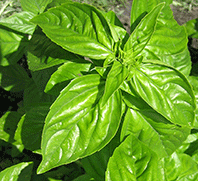 Basil - Sweet 'Genovese'
Basil - Sweet 'Genovese'
 OG
OGAromatic annual herb to 75 cm with shiny green leaves. An essential herb in the summer garden, use in tomato dishes and to make pesto. Sow spring and summer. Suitable for temperate, subtropical and tropical areas. Days to harvest: 80. SB125 (approx. 300 seeds per pkt.) Also on sale as part of a Warm Season Seed Collection SB415 SB126 SB127 SB416 |
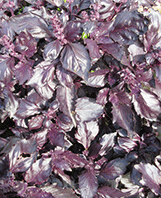 Basil 'Dark Opal'
Basil 'Dark Opal'
 Ocimum basilicum 'Dark Opal' is a very attractive dark purple basil with a good flavour. It grows well in a container and is ornamental. The leaves are mainly purple with 20% variegated or green; useful for adding colour to salads, garnishes and even cut flower arrangements. Days to harvest: 80 SB288 (approx. 150 seeds per pkt.) OG SB329 OG SB289 OG SB370 UT |
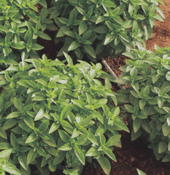 Basil 'Greek Mini'
Basil 'Greek Mini'
 OG
OGA pretty, compact, small-leafed basil growing into a domed shape. The vivid green, 1.5 cm leaves are very aromatic and have a robust basil flavour. Ideal for pots and borders, grows to about 30 cm in height. SB183 (approx. 150 seeds per pkt.) SB361 SB195 SB362 |
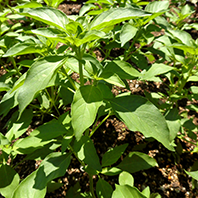 Basil 'Lime'
Basil 'Lime'
 UT
UTAnnual with a zesty lime aroma; compact plant has 4 cm long, bright green leaves; use in soups, salads and fish dishes. SB128 (approx. 150 seeds per pkt.) SB363 SB157 |
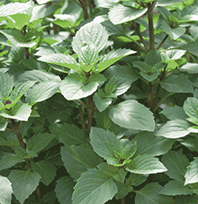 Basil 'Persian'
Basil 'Persian'
 UT
UTPersian Basil is a large, vigorous plant that is a prolific producer of leaves with spicy, lemon and distinctive licorice tones. The taste is closest to that of Thai Basil. It grows as a sturdy plant to 40 cm high with prolific green leaves and beautiful pink flowers, at maturity, that are attractive to bees. Days to harvest: 70. SB458 (approx. 150 seeds per pkt.) SB459 |
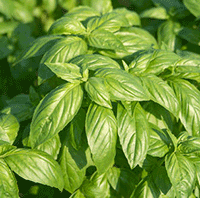 Basil 'Prospera'®
Basil 'Prospera'®
 OG
OGThis is a new hybrid variety of basil with the traditional sweet basil appearance and flavour. The leaves are glossy, dark green and up to 7.5 cm long. It has been bred for resistance to basil downy mildew and fusarium wilt. This is an F1 hybrid so is not suitable for seed saving and is protected internationally by Plant Breeders Rights. Days to harvest: 68 Basil Downy Mildew is a new disease to hit Australia in the last couple of years and it has made it very hard for people in humid areas to grow basil at all. Hopefully 'Prospera' will put pesto back on the menu. SB454 (approx. 100 seeds per pkt.) SB455 SB321 |
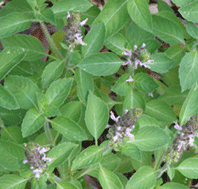 Basil 'Sacred'
Basil 'Sacred'
 UT
UTOcimum tenuiflorum syn. Tulsi, Holy Basil, Tulasi, Kraphao Sacred Basil is native to India and revered by Hindus; it is often planted around shrines. The pale mauve flowers appear late spring to early winter; the green foliage has a spicy, clove-like fragrance. The leaves are used for herbal tea and added to salads. In herbal medicine the distilled oil is used as an antibiotic and insect repellent. It is attractive to bees and beneficial insects. It does well in containers and is traditionally grown for good luck near the front door of the house. Sacred Basil is an annual in cool areas, and a short-lived perennial in frost-free areas. SB255 (approx. 100 seeds per pkt.) SB365 Sacred Basil plants are available seasonally. |
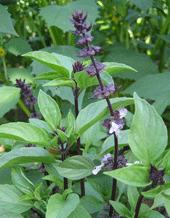 Basil 'Thai'
H
Basil 'Thai'
H
 OG
OGThis beautiful ornamental will give an authentic Thai flavour to meals; it has a sweet, anise-clove fragrance with a hint of mint and citrus. Leaves are green at the base of the plant and grow purple towards the pale lavender flowers. Always add basil at the end of the cooking time to maximise its flavour. Days to harvest: 80. SB131 (approx. 150 seeds per pkt.) SB364 SB184 SB277 |
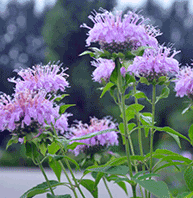 Bergamot
Bergamot

 UT
UTMonarda fistulosa Syn. Bee balm, Oswego tea Bergamot is an aromatic, perennial herb, native to the USA which grows naturally in deciduous forests. It is grown for its pretty mauve flowers, for use in herb teas and for dried flower arrangements. It is attractive to butterflies, beneficial insects and bees. Although a member of the mint family it forms clumps rather than runs. It does best in cooler climates and will go dormant in winter. Grow it in full sun with a moist, fertile soil. In subtropical areas it will prefer light shade but may be relatively short-lived as it dislikes humidity. Sow spring; autumn in frost-free areas only. SB335 (approx. 100 seeds per pkt.) SB336 |
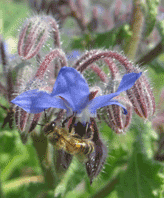 Borage
Borage

 UT
UTBorago officinalis Annual, attracts bees, leaves and pink and blue flowers are edible; accumulates potassium and silica; self-sows. Sow spring and summer; autumn in frost-free areas only. Suitable for temperate and subtropical areas. SB342 (approx. 30 seeds per pkt.) SB413 SB414 SB344 |
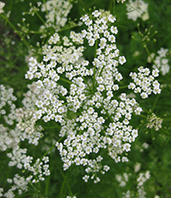 Caraway
Caraway
 UT
UTCarum carvi Syn. meridian fennel, Persian cumin Caraway is an aromatic, biennial, herbaceous herb to 60 cm, mainly grown for its seeds. It prefers cooler climates. The seeds are traditionally used in baking, soups and stews. All parts of the plant are edible, the leaves can be used in salad, the roots cooked like parsnip. The small, white flowers appear in the 2nd year and are attractive to a wide range of beneficial insects including bees. Grow it in partial shade or full sun. It requires a well drained, fertile soil with a pH 6.5 - 7. It germinates best at 21°C soil temperature. In temperate areas sow late spring to summer. In subtropical areas sow autumn. In tropical areas it is unlikely to do well. Germination is slow and erratic. SC576 (approx. 100 seeds per pkt.) SC502 |
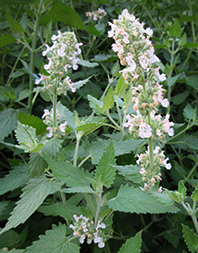 Catnip
Catnip
 UT
UTNepeta cataria Syn. Catmint Catnip is a perennial evergreen herb. It is a hardy, compact, bushy herb to 80cm high that is frost tolerant. The grey-green, heart-shaped leaves are downy; the flowers are pale white with pink splashes and appear in summer. It has a pungent fragrance which is highly attractive and exciting to most cats. The leaves can be dried to make stuffed toys for cats to play with. The leaves are also used as a herbal 'nightcap' tea. It is attractive to bees and butterflies. Sow spring and summer; autumn in frost-free areas only. Suitable for temperate and subtropical areas. SC321 (approx. 200 seeds per pkt.) |
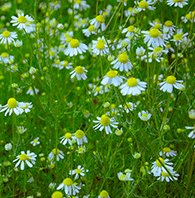 Chamomile - English
Chamomile - English

 UT
UTChamaemelum nobile Syn. Roman chamomile, Lawn Chamomile. Perennial low-growing herb to 25 cm with feathery green leaves and small, sunny daisy flowers. Both leaves and flowers have a fresh, apple scent. The flowers are used to make a relaxing herb tea and as a hair rinse. Harvest the chamomile flowers when fully open, they can be used fresh or dried and stored for later use. Famous for use as a lawn but there is a lot of weeding involved. It does best in areas with cool summers. In temperate areas sow in spring and plant in full sun. In subtropical areas sow in autumn and plant in partial shade. It is likely to be short-lived in subtropical areas. SC498 (approx. 100 seeds per pkt.) SC590 English Chamomile plants are available seasonally. |
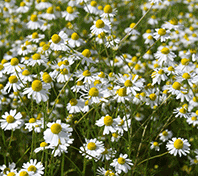 Chamomile - German
Chamomile - German

 UT
UTChamomilla recutita syn. Matricaria recutita German chamomile has white and yellow, small, daisy flowers with a delightful apple fragrance; it is mainly used for making chamomile tea. It is hardy, drought tolerant and has a tendency to self-sow. The flowers can also be used as a hair rinse. It grows to 60 cm high with small daisy flowers. It prefers a well-drained soil in a sunny position. Sow seed in spring. Harvest the chamomile flowers when fully open, they can be used fresh or dried and stored for later use. Suitable for temperate and Mediterranean areas. SC459 (approx. 300 seeds per pkt.) SC460 SC612 SC360 |
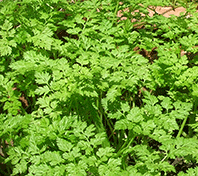 Chervil
UT
Chervil
UTAnthriscus cerefolium Syn. French Parsley Chervil is a low growing herb to 30 cm high with a mild aniseed taste; it is a close relative of parsley. It forms a rosette of sweetly scented, delicate ferny foliage and is ideal for container growing. Chervil thrives in cool conditions and does not tolerate heat; maintain soil moisture to prevent bolting. Used in egg dishes, soups, and with fish. Chervil is one of the four herbs in 'fines herbes' used in French cooking. It germinates best between 12 - 20°C soil temperature. In temperate areas sow late September, early October - December. In subtropical areas sow early spring and autumn. In tropical areas it is unlikely to do well. Germination takes 10 - 14 days, soaking the seed overnight helps to speed it up. Sow direct where it is to grow; as it dislikes being transplanted. Press the seed lightly into soil to 5 mm; it needs light to germinate. It is useful as a herb to grow in partial shade. It does best in a rich, moist, compost-enriched soil with a pH of 5.5 - 7. Try scattering the seed in a 1 m² area; the closeness of other chervil keeps the plants upright. Days to harvest: 30 - 40 days. SC446 (approx. 100 seeds per pkt.) SC447 SC448 Chervil is also available in larger pack sizes as a Microgreen |
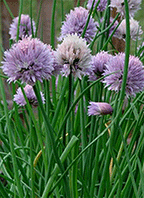 Onion Chives
Onion Chives

 UT
UTAllium schoenoprasum Mildly onion flavoured soft leaves with edible lavender pompom flowers; we won't make scrambled eggs without them! Suitable for temperate and subtropical areas. Onion Chives growing information SC362 (approx. 100 seeds per pkt.) SC363 SC450 Onion Chives plants are available seasonally. |
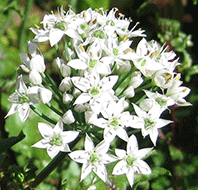 Garlic Chives
H
Garlic Chives
H

 UT
UTAllium tuberosum Syn. Chinese Chives Flat leaf variety of chives with a garlic flavour, attractive white flowers; leaves and green flower buds used in Asian cooking. Suitable for temperate, subtropical and tropical areas. Garlic Chives growing information Garlic Chives plants are available seasonally. |
|
Growing Coriander

Syn. Cilantro Coriander is a frost hardy, fast growing annual to 60 cm high, with small white and mauve flowers in summer; it will self-sow readily. It likes a well-drained soil and full sun. Sow in spring; autumn in frost-free areas Sow seed direct where it is to grow, lightly cover with fine soil or compost. Thin plants to 10 cm apart. The green leaves are used in curries, salads, pesto, chutneys and salsa, the seeds are dry-roasted and used in curries, pickles and soups. The flowers attract beneficial insects including tachinid flies and bees. |
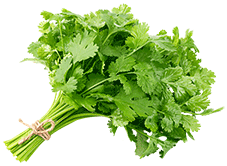 Coriander 'Fiesta Green'
Coriander 'Fiesta Green'

 UT
UTCoriandrum sativum 'Fiesta Green' is a very productive, new variety of coriander that is more bolt-resistant than older forms, it also has more cold tolerance. Coriander is an annual herb used in wide range of dishes, particularly Thai and Mexican cuisine. Sow spring, autumn in frost-free areas only. Suitable for temperate and subtropical areas (cool season only). SC186 (approx. 100 seeds per pkt.) SC187 |
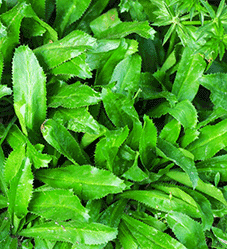 Coriander 'Mexican'
H
Coriander 'Mexican'
H
 UT
UTEryngium foetidum Syn. Culantro, saw-leaf herb, sawtooth herb, long coriander Mexican Coriander is a low growing plant with a rosette growth habit to 40 cm high. The leaves are stiff, long and deeply toothed; the flowers are spiky. It is a short-lived, frost tender perennial; treat it as an annual in cool areas. It has a very similar flavour to coriander but is much more able to cope with hot, humid weather. It is a better choice for subtropical and tropical areas than common coriander as it also dries well and stands up to cooking. The leaves are used fresh or dried in curries, salads, chutneys and salsa. It grows well in containers and prefers partial shade. SC307 (approx. 60 seeds per pkt.) SC308 Mexican coriander plants are available seasonally. |
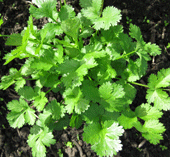 Coriander 'Slowbolt'
Coriander 'Slowbolt'

 OG
OGCoriandrum sativum The most common form of coriander grown. Sow spring, autumn in frost-free areas only. Suitable for temperate and subtropical areas (cool season only). SC149 (approx. 100 seeds per pkt.) SC150 SC151 SC652 |
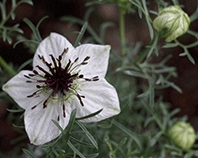 Cumin - Black
UT
No WA
Cumin - Black
UT
No WANigella sativa Syn. kalonj, black onion seed, black sesame Black Cumin is a pretty annual to 20 - 30 cm high with white or pale blue starry flowers. Grow it in a sunny position with well-drained soil. It is a spice used in Indian and Middle Eastern cuisines with a flavour reminiscent of a combination of onions, black pepper and oregano. In cooking, first toast the seeds in a hot pan and then grind well. The seeds are surprisingly nutritious, high in essential fatty acids. It can also be used as an egg replacement in vegan cooking by grinding the seeds and adding water to produce a gel. It is closely related to Love-in-a-Mist which also has edible seeds. Sow spring and summer; autumn in frost-free areas only. Suitable for temperate and subtropical areas. SC494 (approx. 100 seeds per pkt.) No WA SC495 No WA |
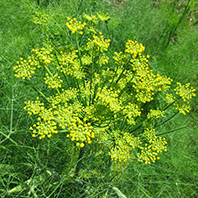 Dill
Dill

 OG
OGAnethum graveolens Syn. dillby; dill weed; shubit; adas manis (Indonesia); pak chee lao (Thai); thi la (Vietnam) Annual, the leaves and seeds are used in cooking; the flowers attract a wide range of beneficial insects. Sow spring and summer, autumn. Suitable for temperate and subtropical areas. SD100 (approx. 100 seeds per pkt.) SD112 SD113 SD105 SD101 |
|
You can find
Fennel seed here
|
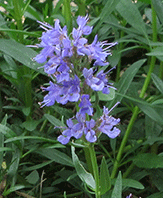 Hyssop
Hyssop
 UT
UTHyssopus officinalis An ornamental herb with pretty bright blue flower spikes in summer, it grows 30 - 60 cm high. It is considered an excellent bee plant, legend has it that beekeepers rubbed their hives with hyssop and other herbs to encourage bees to stay. Hyssop also attracts butterflies and beneficial insects. The flowers were used medicinally in the Middle Ages. It is believed to be a good companion plant for grapes. It is not in general use as a culinary herb but is used to flavour liqueurs, including Chartreuse and in perfumery. It is native to southern Europe and Eurasia and prefers a temperate climate with well-drained soil. It is an herbaceous perennial that is both heat and drought tolerant and it does best in full sun. Sow spring in temperate areas. SH101 (approx. 100 seeds per pkt.) SH104 SH105 |
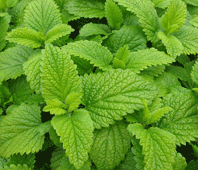 Lemon Balm
Lemon Balm
 UT
UTMelissa officinalis Lemon balm is an herbaceous perennial with a delicate lemon scent. It is a non-running member of the mint family. The leaves are shiny with scalloped edges; small white flowers appear in late spring through midsummer. It attracts bees and butterflies. The fresh or dried leaves are made into a calming herb tea that is used to treat stress, indigestion and headaches. Sow seed in spring; in a cool, semi-shaded position. Suitable for temperate and subtropical areas; unlikely to do well in the tropics. SL181 (approx. 100 seeds per pkt.) SL201 SL194 Lemon balm plants are available seasonally. |
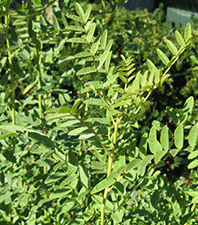 Licorice
UT
Licorice
UTGlycyrrhiza glabra Syn. Liquorice Licorice is a perennial legume to 1.5 m tall that spreads by underground stolons; it dies back in winter. The mauve, pea-like flower spikes appear mid-summer. It prefers a well-drained soil in full sun. Licorice contains glycyrrhizin, which is 50 times sweeter than sugar. The dried roots, which are very hard and fibrous, taste sweet with a slightly bitter aftertaste. The root is used in confectionery and to sweeten medicines. Seed requires stratification. SL123 (approx. 20 seeds per pkt.) Licorice plants are available seasonally. |
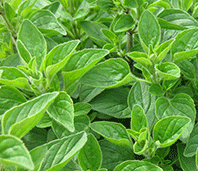 Marjoram - Sweet
UT
Marjoram - Sweet
UTOriganum majorana Syn. Knotted marjoram Has small greyish-green leaves with a milder flavour than close relative, oregano. It is an essential herb in Italian cooking and used in soups, salads, vinegars. It is especially good with egg, tomato and cheese dishes. It does well in a terracotta pot. Container growing is preferred in areas with cold, wet winters or humid, wet summers. SM219 (approx. 100 seeds per pkt.) SM220 Sweet Marjoram plants are available seasonally. |
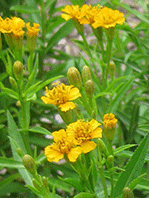 Mexican Tarragon
OG
Mexican Tarragon
OGTagetes lucida An easy to grow perennial, native to Mexico, it prefers full sun and a deep, fertile soil. It grows to 70 cm, producing a cluster of erect stems with long, narrow leaves, 4 cm long and 1 cm wide. Bright golden yellow flowers, 1 cm across, occur in clusters of up to 15 at the top of the plant in summer. The leaves have a distinct aniseed scent and flavour which is similar to French Tarragon but much stronger. Use sparingly as a substitute for French Tarragon in any recipe or make an aromatic tarragon vinegar. Suitable for tropical, subtropical and warm temperate areas. Sow spring. Mexican Tarragon growing information |
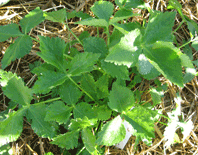 Mitsuba
UT
Mitsuba
UTCryptotaenia japonica syn. C. canadensis Syn. Trefoil, Japanese hornwort, Japanese parsley. A perennial, leafy herb, 50 - 75 cm high, which has a tendency to self-sow in shaded, cool, woodland areas. It is short-lived in hot areas. The leaves are similar in appearance to flat leaf parsley and are used in a similar way. Stems can also be lightly steamed and chopped finely for use in soups and stir-fries. The flavour is reminiscent of celery mixed with a bit of parsley and coriander. Suitable for tropical, subtropical and temperate areas. In temperate areas sow the seeds in spring when the soil is 20 - 25°C. In subtropical areas sow March - May. In tropical areas sow April - June. Days to Harvest: 50. SM123 (approx. 30 seeds per pkt.) SM205 |
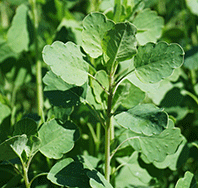 Papalo
UT
No WA
Papalo
UT
No WAPorophyllum ruderale Syn. papaloquelite, Bolivian coriander, yerba porosa. Papalo is an annual plant with a flavour profile similar to coriander; the taste has been described as 'halfway between rocket and coriander'. It predates the use of coriander in Mexican and South American cuisine by thousands of years and is commonly used in salsas. The leaves should be harvested when young and tender, when the flavour is milder. It has a stronger flavour than coriander so much less is needed. It likes to grow from partial shade to full sun and reaches a height of 1 m by 90 cm across. It copes well with hot weather and may self-sow. The flowers are attractive to pollinators and good bugs. SP268 (approx. 50 seeds per pkt.) No WA |
|
Parsley

Parsley is a staple herb, to 30 cm high. It can be planted as a productive, attractive edge to garden beds. It will also grow well in containers. It is the richest in iron of any vegetable. In cooler, temperate area it is biannual. In subtropical and tropical areas it rarely survives the wet season. It germinates best between 12 - 25°C soil temperature. In temperate areas sow late September, early October - December. In subtropical areas sow early spring and autumn. In tropical areas sow April - August. Germination is slow, taking 3 - 6 weeks, soaking the seed overnight helps to speed it up. Days to harvest: 70 - 75 days; always pull the whole leaf away from the base and don't leave a leaf stub. |
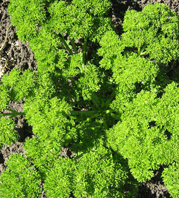 Parsley 'Triple Curl'
Parsley 'Triple Curl'
 UT
UTPetroselinum crispum An old familiar parsley variety that is also the most popular. It has very attractive dark green, highly curled leaves in a rosette. SP235 (approx. 100 seeds per pkt.) SP130 SP203 SP216 |
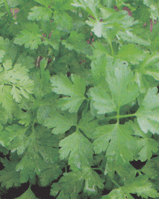 Parsley 'Giant of Italy'
H
Parsley 'Giant of Italy'
H
 OG
OGPetroselinum neopolitanum This is a vigorous, aromatic plant with flat, deep green, shiny leaves. It has a mellow, sweet flavour, rich taste and is hardy and easy to grow. It is suitable for temperate, subtropical and tropical (in the dry season) areas. SP102 (approx. 100 seeds per pkt.) SP338 SP103 SP104 |
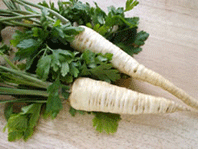 Parsley - Hamburg Root 'Arat'
Parsley - Hamburg Root 'Arat'
 UT
UTPetroselinum crispum var.tuberosum Syn. Parsley Root, Turnip-rooted Parsley Parsley Hamburg Root is an unusual cool season vegetable with both edible leaves and roots. 'Arat' is an improved form with large, smooth roots, similar to a parsnip. The leaves can be used like ordinary parsley but it is mainly grown for the long, tapered, fleshy white roots. The roots have a nutty, celery-like flavour. It can be used steamed, in soups, casseroles or baked. Days to harvest: 88 days. SP241 (approx. 50 seeds per pkt.) |
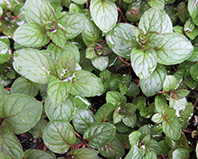 Peppermint
Peppermint
 UT
UTMentha x piperita Peppermint is prone to cross-pollination so when growing it from seed, there is likely to be some variation in the plants. It is a herbaceous perennial, growing to 60 - 100 cm in height; cut the plants back to the ground after flowering. It is mainly used for herb tea, the closely related spearmint has a milder taste and is used in the traditional mint sauce. To harvest and dry for tea, cut the stems before flowering begins and hang the bunches in a cool, dry place. In small gardens always grow mint in a large container, to avoid it taking over. Sow the seeds in spring when the soil is 21 - 25°C. It will grow in full sun or semi-shade, in temperate, subtropical and tropical areas. Peppermint propagates easily from cuttings. Peppermint plants are available seasonally. |
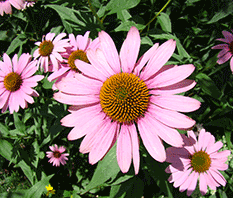 Purple Coneflower
Purple Coneflower
 UT
UTEchinacea purpurea Syn. Echinacea. Purple Coneflower is a hardy herbaceous perennial to 80 cm high with long-lasting purplish pink flowers in summer. It is a native North American wildflower that is highly attractive to butterflies. It is drought tolerant and likes well drained soil in full sun but will grow in very light shade. It is the source of the highly regarded medicinal extract used to boost the immune system, the leaves can also be used as a herbal tea. The seed needs cold weather to germinate; sow autumn to spring. SP345 (approx. 100 seeds per pkt.) SP346 Purple coneflower plants are available seasonally. |
|
|
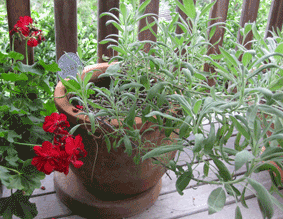 Sage
Sage

Sage is difficult to grow in a garden bed in hot, humid areas but it will do reasonably well on a deck or verandah under a roof or just tucked under the eaves. This is a good way to grow any of the Mediterranean herbs such as rosemary or thyme, which otherwise can be short-lived in the subtropics. Sow seed immediately, sage seed does not store well and is slow to germinate. |
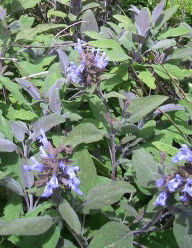 Sage - Common
Sage - Common
 OG
OG
Salvia officinalis Common sage is the main type used for cooking. The grey-green leaves and blue-purple flowers are very pretty. It is a short-lived perennial herb to 50 cm high with an upright, shrubby growth habit. It is frost hardy and drought tolerant. The leaves can be used fresh or dried in a range of savoury dishes, particularly as a bouquet garni, with cheese or duck dishes and as a herb tea. To dry, cut small bunches and hang upside down in a warm, dark, dry place. It makes an attractive cottage garden plant. This herb is known to be difficult to germinate with a low germination percentage. Germination will be improved by soaking the seed at 30°C for 12 hours before sowing. Then sow by pressing the seeds lightly into the seed raising mix but do not cover, as the seeds need light to germinate. Germination takes 10 to 14 days. It is suitable for temperate areas, sow Spring when the soil temperature has reached at least 25°C. If you live in a subtropical area, try growing it in a terracotta pot and moving it under the eaves during the wet season. SS194 (approx. 40 seeds per pkt.) Sage - Common plants are available seasonally. |
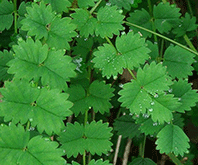 Salad Burnet
UT
Salad Burnet
UTSanguisorba minor Syn. Garden Burnet Salad Burnet has a long history for both its edible leaves and its medicinal properties. It is an attractive, clumping perennial with soft, green leaves in a loose rosette. It is both drought hardy and very cold hardy. It grows to 40 cm in height before it flowers, while the flower heads can be up to 75 cm tall. The small, white flowers are attractive to butterflies. The young leaves with their cucumber-like flavour are harvested to use in salads or dressings. The leaves can also be added to soup and make a very aromatic herb vinegar. If you don't use the leaves regularly then cut back the whole plant from time to time to encourage tender new growth. Salad Burnet prefers a slightly alkaline soil so add a little lime. It will do best in a sunny position but will tolerate some shade and needs plenty of water in hot weather for the leaves to stay tender. It will grow all year around. Sow spring in temperate areas, in subtropical areas sow spring or autumn. It germinates best between 10 - 21°C soil temperature and it is a bit slow to germinate, taking up to 21 days. Suitable for temperate and subtropical areas; unlikely to do well in the tropics. SS290 (approx. 30 seeds per pkt.) SS291 SS339 SS340 Salad Burnet plants are available seasonally. |
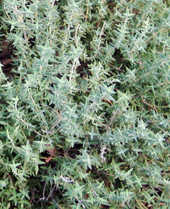 Thyme - Common
Thyme - Common
 UT
UTThymus vulgaris Common thyme is the main type used for cooking. It is a perennial herb to 30 cm high with a semi-upright growth habit. The pale pink flowers appear in spring and summer. The leaves can be used fresh or dried in a wide range of savoury dishes. To dry, cut small bunches and hang upside down in a warm, dark, dry place. Once fully dry, rub the leaves off the stems and store in an airtight jar. It makes an attractive edging plant and can be grown in rockeries. Suitable for temperate areas, sow spring after all danger of frost has passed. ST282 (approx. 100 seeds per pkt.) ST283 ST284 Thyme - Common plants are available seasonally. |
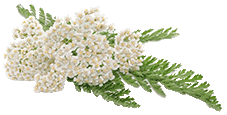 Yarrow - White
Yarrow - White
 UT
UTAchillea millefolium Syn. gordaldo, sanguinary, milfoil, plumajillo Yarrow is a hardy, medicinal, perennial herb used since ancient times. Yarrow leaves combined with peppermint and elderflower is a traditional tea used for colds and flu. The fern-like leaves are arranged in a rosette with ornamental flattened white flowerheads appearing in early summer. The flowers attract bees, butterflies and beneficial insects. The low growing, spreading habit makes it useful as a groundcover. The young shoots can be picked for salad, as they have a slight peppery taste. It can be used as a feed for livestock. The flowers can be used in flower arrangements, either fresh or dried. Handfuls of yarrow are believed to speed up the decomposition of the compost heap and to add soil nutrients such as copper, nitrates, phosphates and potash to the compost. It is also used in biodynamic preparations. The plants spread to form clumps and can become weedy so choose its position carefully. Plants prefer a sunny open position in a well-drained soil but will tolerate light shade. The seeds germinate between 18 - 22°C soil temperature; sow spring in temperate areas; spring or autumn in subtropical areas. Days to bloom: 120 - 130 days SY100 (approx. 250 seeds per pkt.) SY101 SY103 SY104 Yarrow plants are available seasonally. |
|
We also have a decorative variety of yarrow:
Yarrow - Red
|
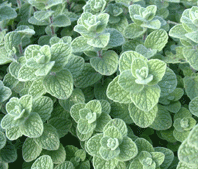 Zaatar
OG
Zaatar
OGOriganum syriacum Syn. Syrian oregano, za'atar, Biblical hyssop, wild marjoram Zaatar is a perennial herb, a relative of oregano, native to the Mediterranean. The attractive greyish-green leaves have a spicy smell and flavour, a combination of sweet marjoram, thyme and oregano. It can be used to flavour hummus, dips and soups. Harvest stems when they reach 6-10 cm long. The plants have a semi-upright habit to 40 cm high. It will grow well in a container. It prefers a well-drained, slightly alkaline soil in a sunny position and will tolerate poorer soils. Sow in spring. SZ109 (approx. 30 seeds per pkt.) Zaatar plants are available seasonally. |
|
Egyptian Spinach also known as Molokhia
is available as seed.
|
At Green Harvest we are passionate about open-pollinated, heirloom seed as we believe it is a resource belonging to all people,
not a product to be exploited by a few. Open-pollinated vegetable seeds are genetically diverse treasures that have been passed
on from generation to generation of gardeners. We invite you to contact us
if you would like to help us preserve open-pollinated seed varieties in Australia.
More information on seed saving...
|
Green Harvest specialises in seeds which are:
|
A
free
Successful Seed Raising Guide is included with your first seed order from Green Harvest.
Seed to WA:
A $6.95 Quarantine Fee will be charged for all seed orders to WA. Green Harvest is sharing the cost of
the quarantine fee with all our WA customers.
Read more...
 Home
Home
Green Harvest Organic Gardening Supplies is permanently closed as of 5pm on 1-11-2023.
We will not be taking orders by this website, in person, by phone or email. Our display garden and retail shop are closed forever.
Read more...
Phone:07 54357000
Phone calls will only be responded to sporadically and only in reference to orders placed prior to 2-11-2023. All the useful growing and organic pest management research and resources are available on this website for a while still.
We guarantee our seeds to the value of the purchase price. We are happy to replace the seeds, give you a credit or refund, whichever you prefer. Other than our guarantee to the extent of the purchase price Green Harvest gives no other warranty expressed or implied. No liability will be accepted by Green Harvest, its owners or employees as to the accuracy of any information. No responsibility will be taken for damage to property or persons due to information given about a product or technique. No responsibility will be taken for the loss of a crop or income due to information given about a product or technique.
 Shopping here is private and secure.
Shopping here is private and secure.
Copyright © 2001 - 2024 Green Harvest Organic Gardening Supplies
No part of this website may be reproduced without permission of the owner
